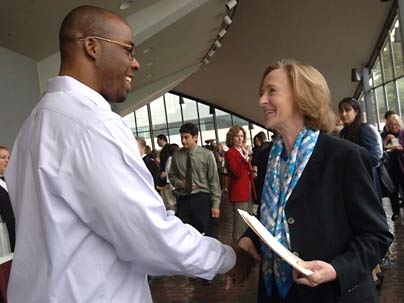A record number of applications, an all-time high in fundraising and the launch of several new campus-wide and global initiatives helped make the past year a strong one for MIT, President Susan Hockfield reported Oct. 2 at the annual State of the Institute Forum.
Hockfield and other senior administrators spoke at the forum, held at Kresge Auditorium and attended by several hundred members of the MIT community.
Hockfield asked every member of the community to re-commit to the stewardship of MIT and preservation of its core values--personal integrity, taking pleasure in hard work, and commitment to meritocracy.
"It is our responsibility to invent the future, in both research and education," Hockfield said. "I believe very deeply that the world needs MIT as much now as it ever has before."
The state of MIT is "very, very strong," and has grown stronger over the past year, Hockfield reported.
In the past two years, MIT has received record numbers of undergraduate applications, with a 9 percent increase in each of the past two years. This year, MIT accepted 12.3 percent of the record-high 12,443 applicants, and 69 percent of those accepted decided to attend MIT.
"Any way you look at these numbers, it shows a very strong draw for young people to MIT," Hockfield said.
MIT took in a record $332 million in total fundraising, a 37 percent increase over the 2006 total. Hockfield attributed that growth to early success of the Campaign for Students, which was announced in December 2006 with the goal of raising $500 million for undergraduate financial aid, graduate fellowships, new educational initiatives and student life.
Hockfield noted that the senior leadership team has undergone a great transition in the past year, with new deans for the Schools of Engineering and Science and the Sloan School of Management, plus several new vice presidents and other senior administrators.
She also reviewed the many collaborations that MIT has launched or joined in the past year, including the MIT Energy Initiative (MITEI), the Singapore-MIT Alliance for Research and Technology (SMART), the Legatum Center for Development and Entrepreneurship, the Boston Area Autism Consortium and the Stanley Center for Psychiatric Disease.
MITEI, a campus-wide initiative to help transform the global energy system to meet future needs, has made great strides in the past year, Hockfield said. At the forum, she announced that four inaugural sponsors have signed on to support MITEI programs--BP (coal conversion), Ford (automotive technology), Ormat Technologies (geothermal power) and Phil Rettger (solar power). More energy partners will be announced in the coming weeks, she said.
With funds provided by the sponsors, MITEI has set up a seed fund and issued a call for proposals for energy-related research. Hockfield encouraged faculty, especially junior faculty, to apply for the funding. She also announced that over the next five years, MITEI will support 100 energy fellows, who will undertake research in a range of energy topics, from engineering to policy to economics.
Hockfield talked about the need for MIT to remain a "talent magnet," especially in recruiting a diverse faculty and student body.
"We really want MIT to be seen by people as the place you have to be if you want to be at the cutting edge," she said. "To be the best, you have to recruit the best."
That means accelerating the progress MIT has made in recruiting and retaining minority faculty and students, Hockfield said. The Institute has done well in that area, she said, "but we have to get even better."
After Hockfield spoke, Provost L. Rafael Reif outlined his goals for this year, which include increasing collaboration among MIT's five schools, assessing the strengths and weaknesses of each school, increasing diversity of faculty and students, and promoting general Institute initiatives such as MITEI.
Chancellor Phillip Clay discussed the new fundraising Campaign for Students and the Task Force on the Undergraduate Educational Commons. Clay said he is committed to implementing the task force recommendations that don't need to wait for a faculty vote, such as improving undergraduate advising and promoting greater participation in international programs.
Theresa Stone, executive vice president and treasurer, reported that MIT's finances are in good shape. The Institute's total assets are $12.7 billion, and its endowment is $10 billion. Last year's endowment rate of return was 22.1 percent.
Stone also reported that several new building and renovation projects are underway or recently completed--PDSI, Whitaker College renovation, Media Lab/ School of Architecture addition, new Sloan School building, new cancer research facility, Vassar West streetscape and the 600 Memorial Drive renovation.
A version of this article appeared in MIT Tech Talk on October 17, 2007 (download PDF).






